
The One About Thanksgiving, "Friends"
❖❖❖
IN THIS ISSUE
LYNDHURST MANSION
By John Mariani
NEW YORK CORNER
FLAMES STEAKHOUSE
By John Mariani
ANOTHER VERMEER
CHAPTER 45
By John Mariani
NOTES FROM THE WINE CELLAR
WINES FOR THANKSGIVING
By Geoff Kalish
❖❖❖
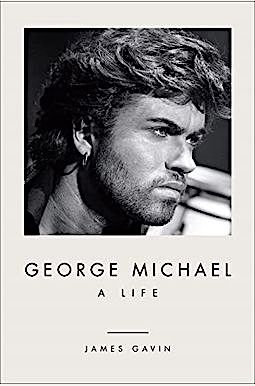
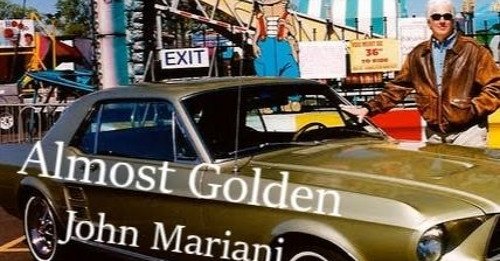
❖❖❖
LYNDHURST MANSION
Tarrytown, NY
%20SMALL.jpg)
By John Mariani
Henry
James called the Hudson River America’s “great
romantic stream,” and having once lived along
its banks, I have never forgotten the
peacefulness that a long view of it instilled
upon my senses as it flowed silently down from
West Point southward to the sea. The Hudson
Valley is certainly one of the richest regions
for historic landmarks, and the names of its
villages—Spuyten Duyvil, Pocantico Hills,
Yonkers, Sleepy Hollow, Katonah, Rhinebeck,
Fishkill, Tarrytown—evoke its Native American,
Dutch and British legacies.
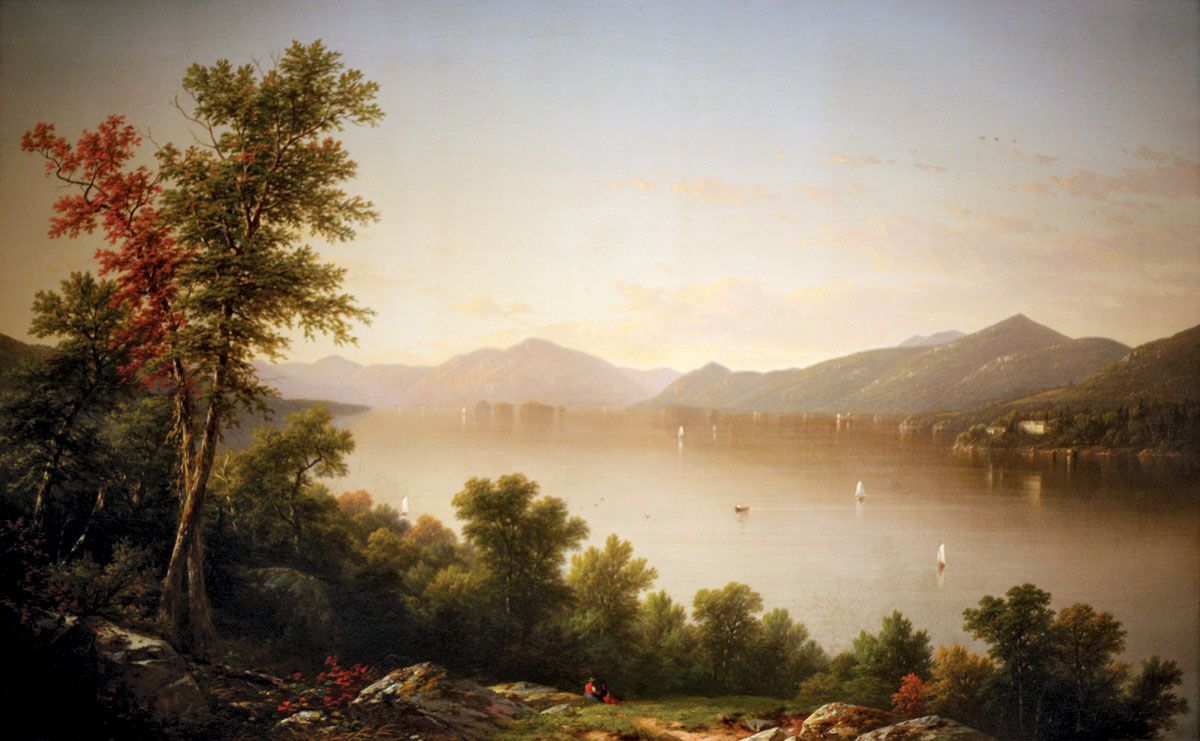 The
preservation and restoration of so
many historic properties have been consistently
among the finest, including Washington Irving’s
home, Sunnyside; George Washington’s Headquarters
in Newburgh; the John Jay Homestead in Katonah;
and The Cloisters in Fort Tryon Park. One of the
most extraordinary is Lyndhurst, a half-mile south
of the Mario M. Cuomo Bridge (which New Yorkers
still call the Tappan Zee Bridge), of which
architectural historian William H. Pierson Jr.
said, “when completed in 1866 Lyndhurst was the
most profoundly intelligent and provocative house
to be built in this country since Thomas
Jefferson’s Monticello.” And it is indisputably
America’s finest example of a Gothic
The
preservation and restoration of so
many historic properties have been consistently
among the finest, including Washington Irving’s
home, Sunnyside; George Washington’s Headquarters
in Newburgh; the John Jay Homestead in Katonah;
and The Cloisters in Fort Tryon Park. One of the
most extraordinary is Lyndhurst, a half-mile south
of the Mario M. Cuomo Bridge (which New Yorkers
still call the Tappan Zee Bridge), of which
architectural historian William H. Pierson Jr.
said, “when completed in 1866 Lyndhurst was the
most profoundly intelligent and provocative house
to be built in this country since Thomas
Jefferson’s Monticello.” And it is indisputably
America’s finest example of a Gothic 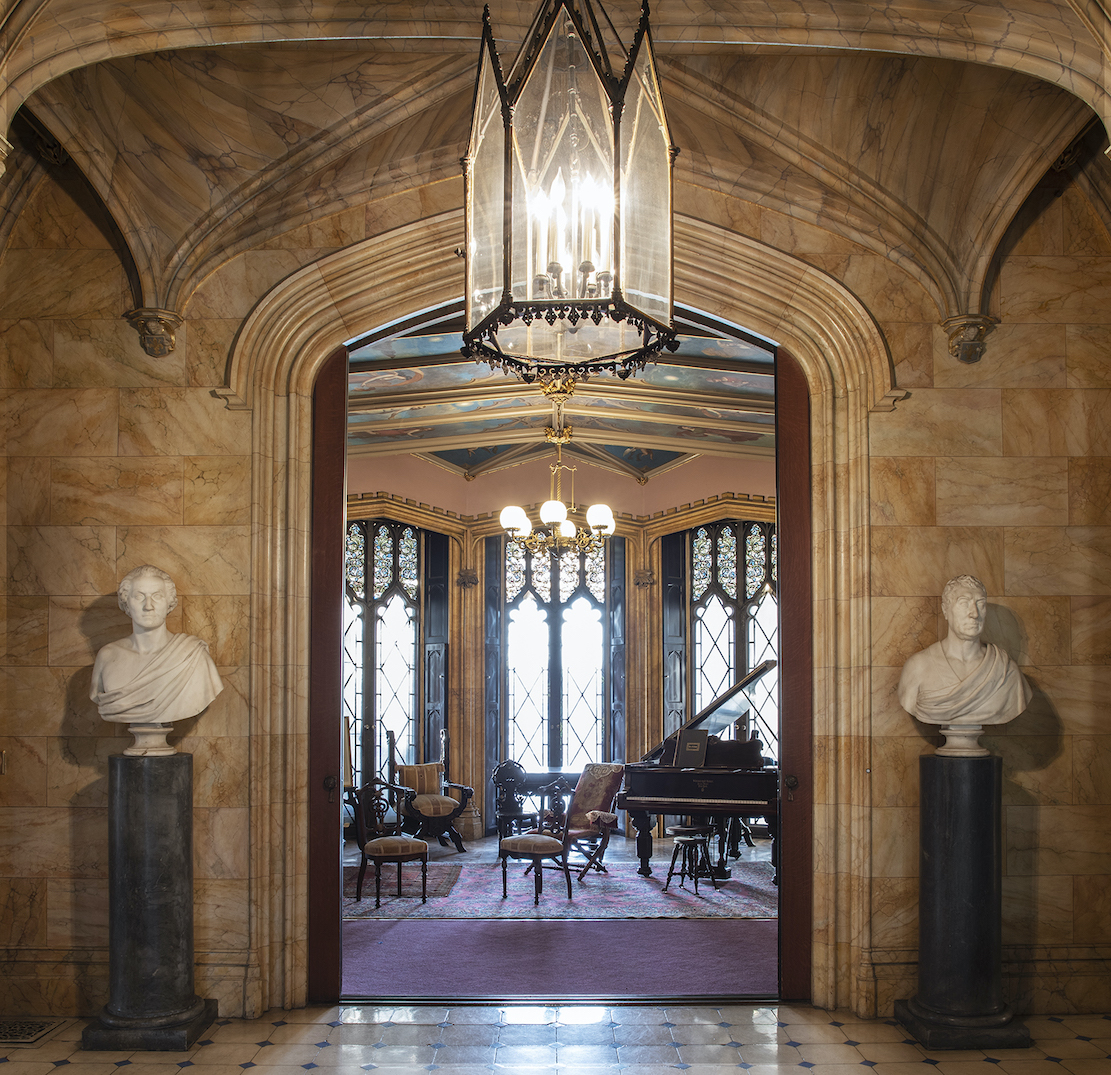 Revival
mansion.
Revival
mansion.
Spread over 67 acres, the estate’s trees
had all been planted at a time when this was all
farmland. Designed in 1838 by
Alexander Jackson Davis on the original hunting
grounds of the indigenous Lenape/Munsee tribe, the
estate was a
summer’s retreat for the only three family owners
it ever had.
William S. Paulding, a military man and
politician who was a neighbor of Washington
Irving, lived there off and on, as did his son as
of 1850. Owing to Lyndhurst’s unique design, many
snickered at it as “Paulding’s Folly.”
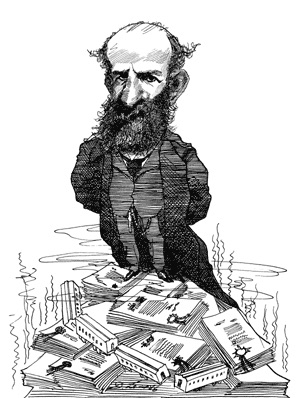 The next owner was merchant
George Merritt, who, after the Civil War, expanded
the structure and updated the interior furnishings
with a grand new dining room. Certainly the most
famous of Lyndhurst’s occupants was Jay Gould (left),
who purchased the estate in 1880, and, despite
having his offices in Manhattan, returned home on
his own private steamer to dine with his family
each night. History has placed Gould among the
most notorious “robber barons” of the Gilded Age,
along with fierce competitors like J. Pierpont
Morgan and Andrew Carnegie, although recent
revisionist historians have credited him with
significant public achievements as well as
enormous commitments to charity from which he
withheld his name as donor.
The next owner was merchant
George Merritt, who, after the Civil War, expanded
the structure and updated the interior furnishings
with a grand new dining room. Certainly the most
famous of Lyndhurst’s occupants was Jay Gould (left),
who purchased the estate in 1880, and, despite
having his offices in Manhattan, returned home on
his own private steamer to dine with his family
each night. History has placed Gould among the
most notorious “robber barons” of the Gilded Age,
along with fierce competitors like J. Pierpont
Morgan and Andrew Carnegie, although recent
revisionist historians have credited him with
significant public achievements as well as
enormous commitments to charity from which he
withheld his name as donor.
Gould died of tuberculosis in 1892, when
his eldest daughter, Helen, a great philanthropist
in her own right, became steward of the estate,
adding a 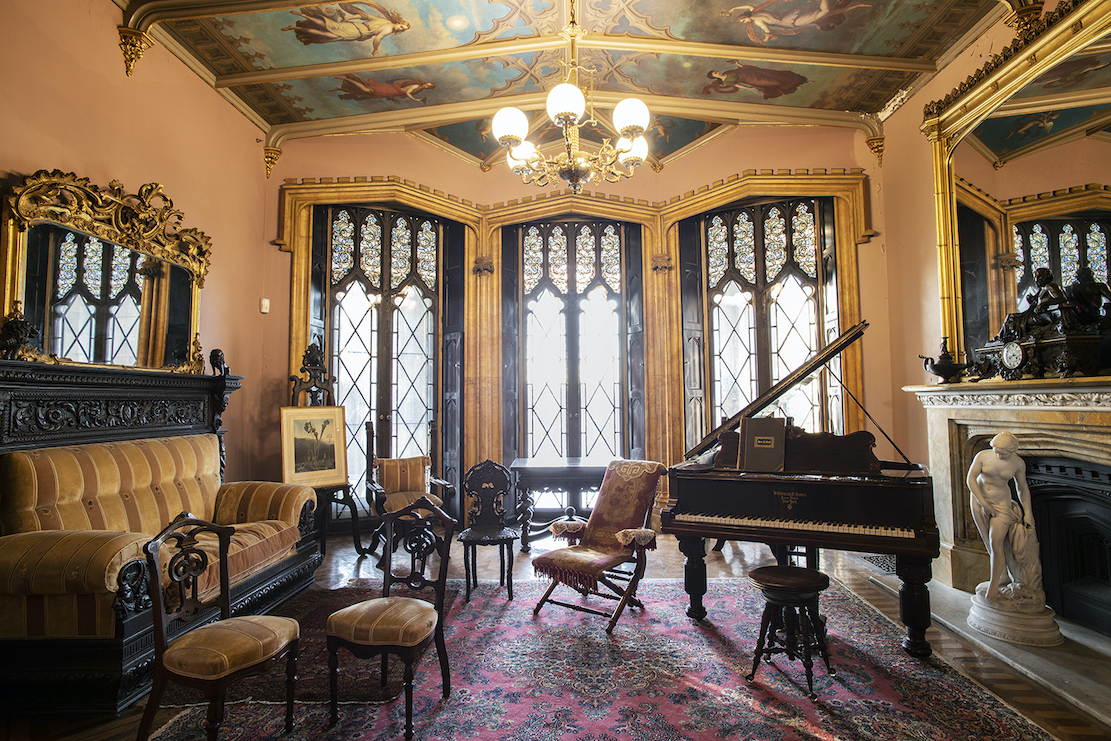 kennel,
laundry building, pool building and bowling alley,
as well as opening it up to disadvantaged children
for free sewing, cooking, and carpentry classes.
She also supported many women’s programs. Gould’s
youngest daughter, Anna, who was well known and
much sought after in international society,
finally married, becoming the Duchess of
Talleyrand-Périgord and moving to France, but she
continued to maintain Lyndhurst, which she opened
up for charitable events. On her death in 1961,
Anna bequeathed the house, which she had kept in
impeccable, period condition, to the National
Trust for Historic Preservation. It opened as a
museum and historic site in 1965.
kennel,
laundry building, pool building and bowling alley,
as well as opening it up to disadvantaged children
for free sewing, cooking, and carpentry classes.
She also supported many women’s programs. Gould’s
youngest daughter, Anna, who was well known and
much sought after in international society,
finally married, becoming the Duchess of
Talleyrand-Périgord and moving to France, but she
continued to maintain Lyndhurst, which she opened
up for charitable events. On her death in 1961,
Anna bequeathed the house, which she had kept in
impeccable, period condition, to the National
Trust for Historic Preservation. It opened as a
museum and historic site in 1965.
 Visiting
Lyndhurst today, which includes separate tours of
the interior and of the vast estate, can be done
in an hour or two, leaving you to also visit
nearby Sleepy Hollow or the Hudson River Museum in
Yonkers. After
being shuttered during the pandemic, Lyndhurst has
become more of an attraction than ever, so that
the tours fill up fast, making the purchase of
tickets in advance essential. You collect your
tickets at the former stables and join a group led
by long-time guides, whose formal knowledge of the
estate’s history is leavened with anecdotes about
those who have come through over decades.
Visiting
Lyndhurst today, which includes separate tours of
the interior and of the vast estate, can be done
in an hour or two, leaving you to also visit
nearby Sleepy Hollow or the Hudson River Museum in
Yonkers. After
being shuttered during the pandemic, Lyndhurst has
become more of an attraction than ever, so that
the tours fill up fast, making the purchase of
tickets in advance essential. You collect your
tickets at the former stables and join a group led
by long-time guides, whose formal knowledge of the
estate’s history is leavened with anecdotes about
those who have come through over decades.
Despite the imposing size and looming
towers of the edifice, the sense that this really
was a family retreat is palpable in finding that
for much of its early days there was no
electricity or gas with which to light or heat the
house. The original rooms are not as spacious as
one might have imagined for a very wealthy family,
but Merritt’s additions gave it both breadth and
depth, especially in the upstairs gallery, whose
Tiffany windows (among many Tiffany works) brings
in the Hudson Valley light to the great advantage
of the extraordinary collection of European and
American artwork displayed. Just above the gallery
is a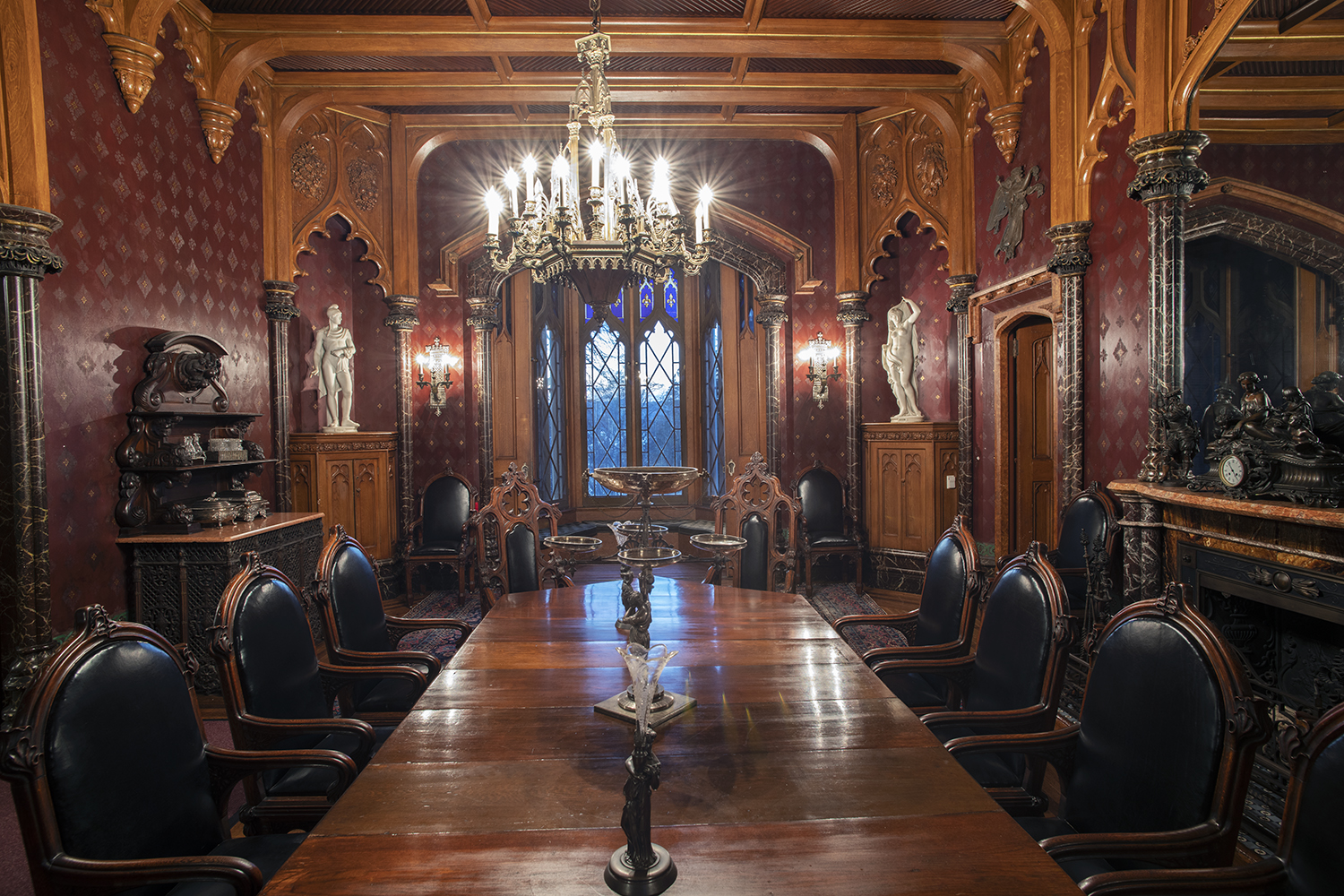 room where a small group of musicians and singers
would perform.
room where a small group of musicians and singers
would perform.
The library is arrayed with
rare 19th century volumes, and the bedrooms are
all of a different style, including Anna’s, which
copied the beauty of the arched ceilings of
Paris’s Sainte-Chapelle. The amount of carved
wood, balustrades, walls painted to look like
marble, and bas-relief wallpaper has a range few
museums possess within such a compact space, and
the fact that it has been so little altered in
over 175 years has made it an ideal place for
shooting period films and TV shows, which have
included Dark Shadows
(1970) "Collinwood" and The Gilded
Age series; it has also hosted the 2022
Westminster Kennel Club Dog Show.
Throughout the time when Lyndhurst is open
(it closes this year after Christmas and re-opens
in March), activities and presentations are held,
which includes an M&M Performing Arts and Red
Monkey Theater production of the Sherlock Holmes
mystery “The Adventure of the Red-Headed League.”
The house is completely festooned for the
holidays, with several performances in December of
“Mr. Dickens Tells a Christmas Carol.” On December
11 the Collective Brass ensemble performs at the
Carriage House with seasonal favorites, including
“The Nutcracker” and the “Hallelujah Chorus.”
And
behind it all flows the majestic Hudson River and
beyond that all of America.
❖❖❖
FLAMES STEAKHOUSE
121 East Main Street
Elmsford, NY
914-592-3500
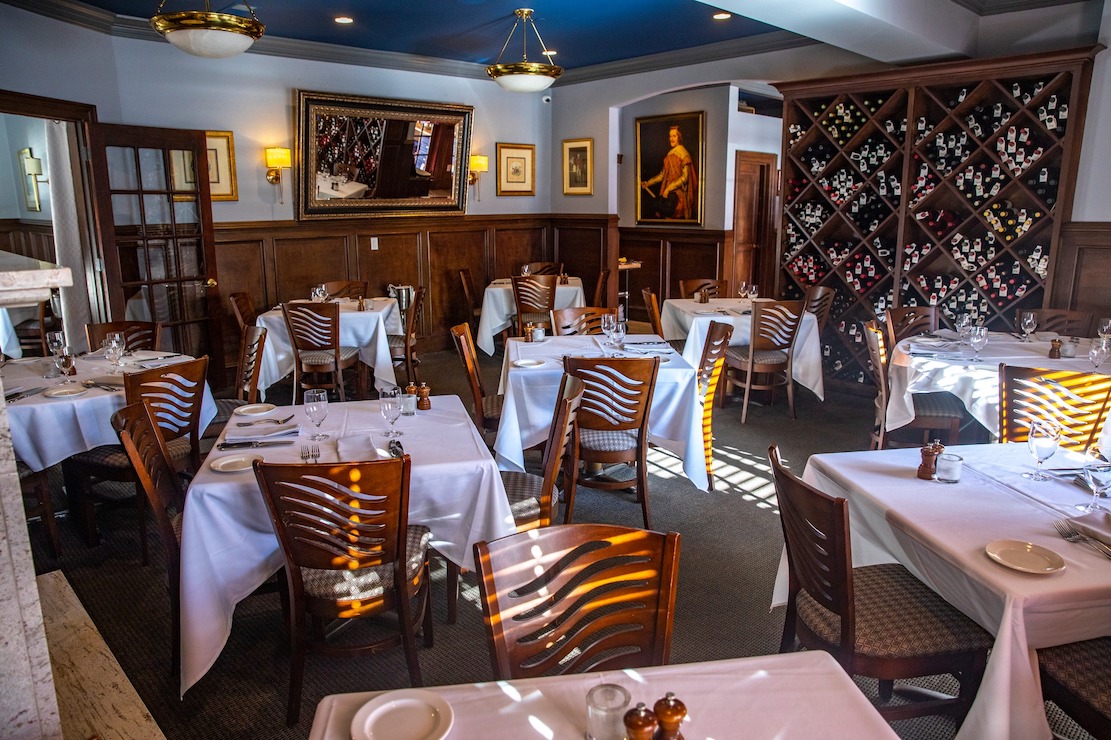
By John Mariani
As any reader of this column knows, I
am always delighted to write about a great old
or new steakhouse in Manhattan—Gallaghers,
Empire, Benjamin Prime and several others—and to
ignore those whose beef just doesn’t come up to
the standards New York steakhouses set decades
ago, when the original Palm, Christ Cella and
Peter Luger’s battled to get the very best USDA
Prime available. Simple arithmetic would tell
you that every one of the New York and national
steakhouse chains can’t possibly obtain enough
first-rate product every night.
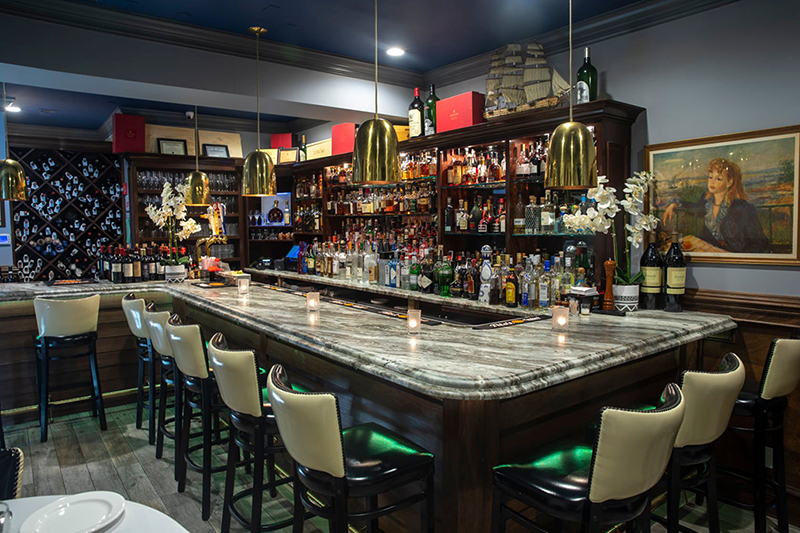 An individual owner’s longstanding
relationships with the meat vendors (especially
now since the Meat District has been turned into a
street of boutiques)
is
critical in guaranteeing a consistent supply of
great beef. Nick Vulaj has maintained those
relationships for more than 30 years, so that his
Wall Street area restaurant Flames is the best one
down there, and he serves exactly the same quality
at his suburban branch of Flames in Elmsford, New
York, opened in 2016. If a Texan will drive four
hours to a barbecue stand and a Californian can
cross the border for Mexican food, anyone in the
tristate area should consider an hour’s drive or
train ride from Grand Central Terminal to dine at
Flames.
An individual owner’s longstanding
relationships with the meat vendors (especially
now since the Meat District has been turned into a
street of boutiques)
is
critical in guaranteeing a consistent supply of
great beef. Nick Vulaj has maintained those
relationships for more than 30 years, so that his
Wall Street area restaurant Flames is the best one
down there, and he serves exactly the same quality
at his suburban branch of Flames in Elmsford, New
York, opened in 2016. If a Texan will drive four
hours to a barbecue stand and a Californian can
cross the border for Mexican food, anyone in the
tristate area should consider an hour’s drive or
train ride from Grand Central Terminal to dine at
Flames.
It’s a fine-looking restaurant with a
popular white-and-gray polished marble bar, walls
of wine from a 250-label list, neatly covered
tables with handsome sturdy chairs, wainscoting
and a rear dining room put to 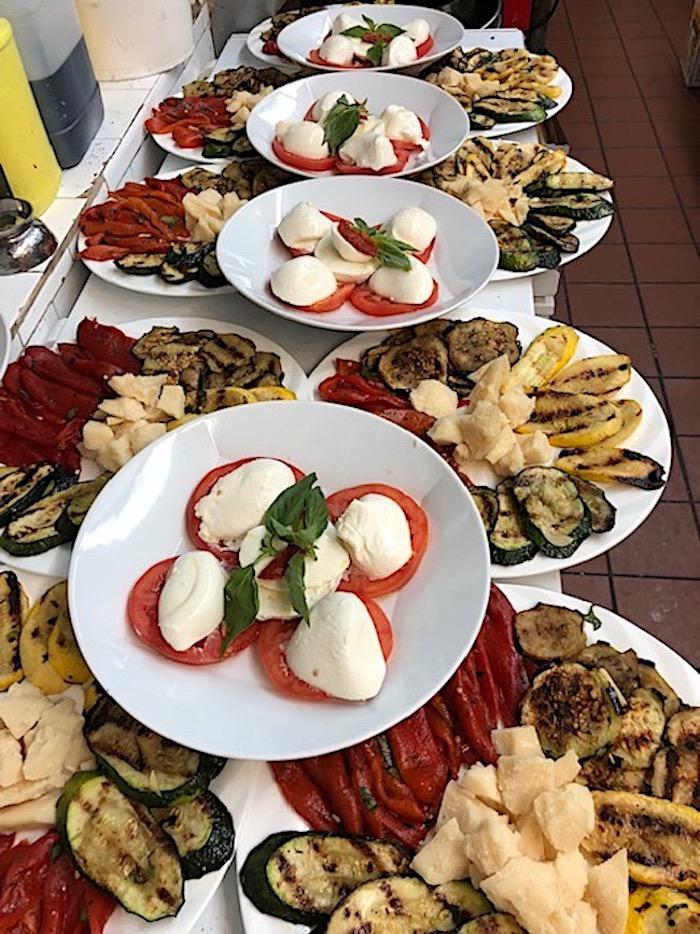 use
for parties.
use
for parties.
You may start off with a lavish seafood
tower for two or more (priced accordingly) or just
indulge in a copious cocktail of true jumbo lump
crabmeat ($27)—which, if you can find it at the
store is going for $50 a pound—or perhaps a
platter of blue point oysters ($19.95). I usually order the
eggplant rollatini with prosciutto and melted
fontina ($17.50), and the spaghetti alla
carbonara “made the right way”($39) is
right on the mark and makes a great appetizer.
Burgundy-flesh tuna 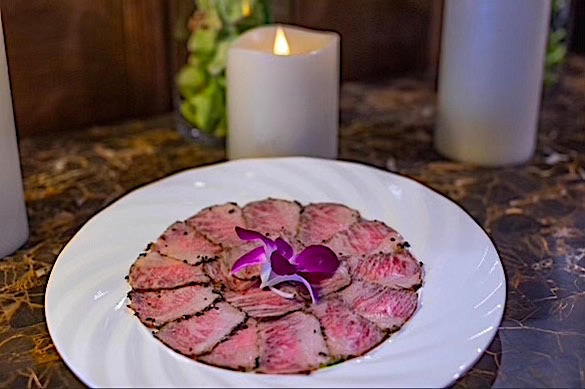 comes with a
moderate wasabi sauce. French onion soup, new to
the menu ($13.95), was a classic rendering, as
is carpaccio of beef with a light dressing
($44.95).
comes with a
moderate wasabi sauce. French onion soup, new to
the menu ($13.95), was a classic rendering, as
is carpaccio of beef with a light dressing
($44.95).
Before I get to the steak, I highly
recommend the four well-cut American lamb chops
($64), of which at least one is likely to leave
with you in a doggie bag. The veal chop with
mushrooms ($65) weighs in at about 16 ounces. You
can also get some massive lobsters (MP), and
there’s grilled branzino ($48.95) for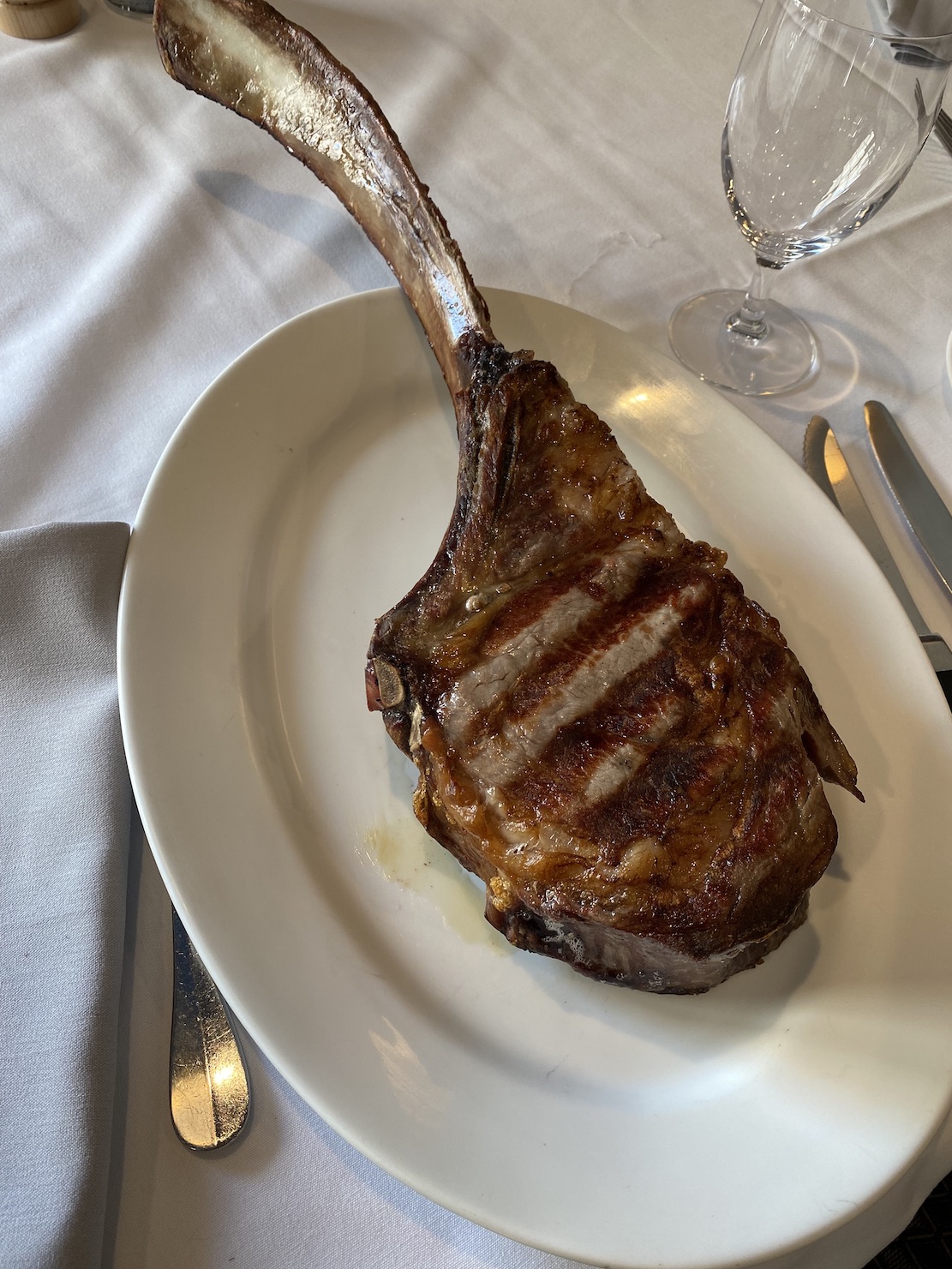 those
who eschew meat.
those
who eschew meat.
Vulaj took
wagyu beef off the menu a while back for good
reason: except for its unctuous fattiness, wagyu,
Japanese or otherwise, is simply not as flavorful
as his mineral-rich USDA Prime steaks, either a
bone-in ribeye ($69), shell steak ($65) or
porterhouse for two or more ($145 ). A
tomahawk steak ($95) is a lot of meat and a whole
lot of bone, for show really. I am not usually a
fan of filet mignon for the opposite reason from
wagyu, that it hasn’t enough fat, but somehow,
Flames’s massive hunk of filet with the bone
(which makes a difference) with mushrooms ($79)
could change my mind. It had
fine texture, juiciness and flavor throughout.
change my mind. It had
fine texture, juiciness and flavor throughout.
From onion rings ($16.95) to French fries
($16.95) and garlic-mashed potatoes ($16.95), the
sides are all worthwhile, and if you really need
dessert, Flames has the usual cheesecake ($12.95),
though I can’t resist its old-fashioned carrot
cake ($17.95).
You pay a high
price for this quality, but I’ve come to realize
that only a trencherman would polish off every
morsel of such gargantuan portions, so you get a
second meal out of the deal. In any case, Flames
is worth the money and worth the effort to get
there.
Open daily for lunch and dinner.
ANOTHER VERMEER

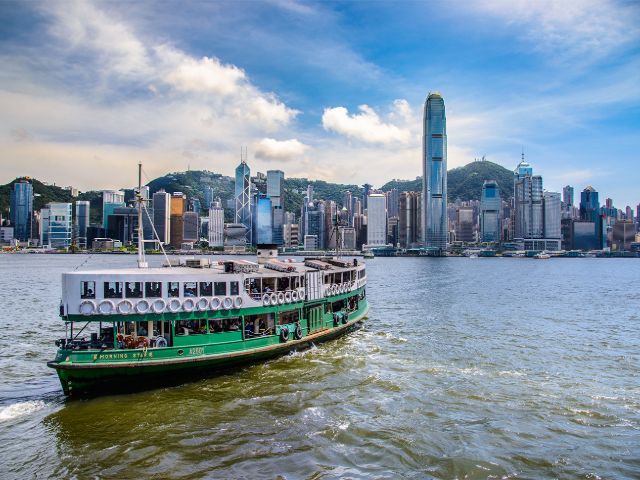
For its size,
however, the boat was actually very fast and by
six o’clock the next day pulled into the Sai Wan
Ho Marine Police Headquarters in Hong Kong
Harbor. There
Katie and David were met by both plainclothes
and uniformed officials, one of whom spoke very
good English. He was perhaps in his forties.
 “Welcome
to Hong Kong,” he said. “My name is Li Tao and I
am the head of police here. I hope your trip to
Hong Kong was not so uncomfortable.”
“Welcome
to Hong Kong,” he said. “My name is Li Tao and I
am the head of police here. I hope your trip to
Hong Kong was not so uncomfortable.”
“No,” said Katie, “We were treated very
nicely, thank you.”
“Good, I am glad to hear that. Now, we
would like you to have a good night’s sleep at our
headquarters, and then we will take your statement
on what happened to you, and, if all goes well,
you will be transferred to the American Consulate
in Hong Kong.
We have already contacted them about your
presence.”
Katie and David both breathed a sigh of
relief and thanked Mr. Tao.
“Will
we have a chance to make some phone calls?” asked
Katie.
“I’m sure that will be fine in the morning,
after our interview is over.”
David knew that would be standard procedure
in most countries, still confused as to what the
time change was between Hong Kong and New York.
They’d been accused of nothing, so there was no
need to request a lawyer.
The officials brought them to the nearby
headquarters (below), they were given a
good dinner and comfortable rooms for the night.
The next morning they were awakened at eight
o’clock, brought to breakfast and then to Mr.
Tao’s office, where the interview began
immediately.
The Chinese officials had already learned a
good deal about the events on the trawler, and it
was quite obvious that the Americans had
been kidnapped—David liked to say “shanghai-ed”
now that he was safe—and brought out beyond the
legal limit so that if, by some miracle, the
bodies had been discovered, there was no proof of
which side of Taiwan Strait the trawler had come
from. It
was pure luck that the Chinese police boat found
the trawler in those waters, although ever since
the missile testing in the area the region had
called for better vigilance by both sides.
In giving their version of the story, Katie
began with the reasons they were in Taipei to see
Shui, about the murder of the American couple, and
the interview with Shui that ended with their
being kidnapped. Tao said nothing about Shui until
David asked, “Do you know this man Hai Shui?
Tao said, “Very well, very well. We Chinese
consider him one of the worst thieves of our
artistic heritage and wealth when his family
joined Chang Kai-Shek and escaped to Taiwan. Were
he to step foot in China, he would be arrested and
tried for treason.”
Katie then realized Shui himself would
never dare attend the upcoming auction but would
have an emissary there, or perhaps just phone in
his bid on the Vermeer.
“Are you by any chance aware of this sale
of a painting by the artist Jan Vermeer next
week?”
Tao shook his head and said, “I was not,
until you told me your story. But, if it is true,
and if Hai Shui tries to buy the painting, it
would be another example of his treachery. Now that
it has come to light, I would say our government
would never allow the painting to leave Hong
Kong.”
Katie and David had no idea what the
ramifications were if Shui outbid everyone
else—after all, the Chinese were trying to get as
much money as possible from the sale of a painting
that they did not consider part of their cultural
heritage. But
when the story came out about Shui, he would be
barred from bidding, probably already under arrest
by Interpol or the Taipei police.
“Well, then, I am sure my colleagues and I
will have more questions for you,” said Tao, “but
I think we can safely transfer you to the American
Consulate now. We do ask that you remain their
guests to help us with our investigation.”
“Do you know how long that will be?” asked
David.
“Justice is faster here in China than in
your country, but I believe you will be able to
return to the United States within ten days.”
Katie and David looked at each other and
smiled. It was just enough time to cover the
actual auction, which was scheduled for the
following Thursday.
“Well,” said David, “It looks like we have
an all-expenses paid holiday in Hong Kong and get
to be right in the room when the painting goes up
for sale.”
“I know,” said Katie, “though I’ll have to
discuss it with my editor. I can’t imagine he’d
object to the American Consulate General taking
care of us, as long as he gets a good story out of
all this. I can’t wait to tell him everything
that’s happened. He’ll love the fact we almost got
killed.”
Both
Katie and David knew that not enough time had gone
by for their friends, colleagues and family
members to wonder why they hadn’t heard from the
two of them, but the first call Katie wanted to
make was to her parents, David to Kiley.
“You know, the story about Chin trying to
knock off Lauden should be in the American papers
by now, don’t you think?” she asked. “Trying to
kill one of New York’s most prominent
billionaire-philanthropists would be big news.
Wonder where we can get a paper.”
“The Consulate will have all the latest
news,” said David. “Plus, a lot of the papers may
not even have it.
Obviously, our guys have been informed
about what happened to us.”
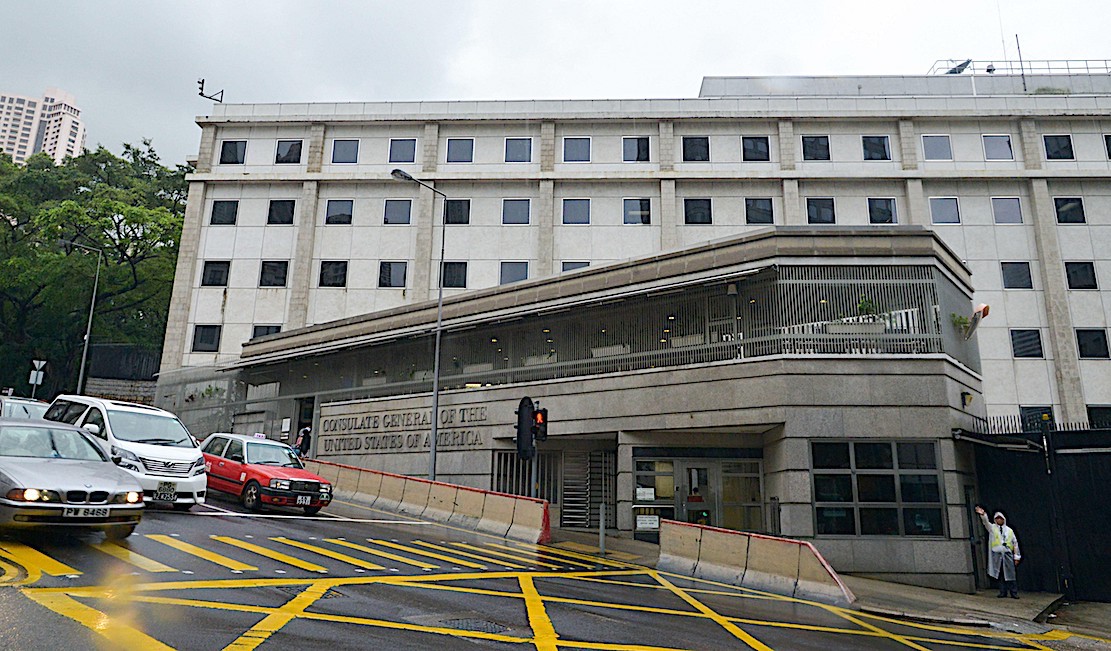 A
police car took Katie and David to the
Consulate (the U.S. Embassy was in Beijing), which
dated back to 1848 but since the 1950s was located
in a drab concrete bunker-shaped building on
Garden Road near Hong Kong Park. The
Consul General, in his fifth year, greeted them at
the front door.
He introduced himself as Michael Curren.
A
police car took Katie and David to the
Consulate (the U.S. Embassy was in Beijing), which
dated back to 1848 but since the 1950s was located
in a drab concrete bunker-shaped building on
Garden Road near Hong Kong Park. The
Consul General, in his fifth year, greeted them at
the front door.
He introduced himself as Michael Curren.
“Well, you two have had quite a week,” he
said. “We’ve been briefed by the Chinese, but of
course we want to hear the story from you. Come
in, come in.
Coffee? I suppose you’ve had enough tea.”
The Consulate was large but segmented into
offices for commercial dealings, granting visas,
and obtaining passports.
“We don’t get many requests for asylum,”
said Curren, “so we’re really not set up to house
you here, but I hope you’ll accept my wife’s and
my invitation to stay at our residence. We’ve
plenty of room since our kids went to the states
for college.”
They exchanged pleasantries, and Katie and
David were ushered into a conference room to speak
with Curren and several other Consulate officers.
Katie asked, “Would it be possible to call
some people in the States to tell them we’re all
right?”
“Certainly,” said Curren. “How about we
leave you alone here with the phones for, what?
Half an hour? These are all pretty secure lines.”
“That
would be great,” said David.
There were four
phones set around the room, with two on the
conference desk. Katie first called her parents—it
was nine p.m. in New York—and told them everything
was fine, that she and David had had a little
adventure but she’d tell them about it when she
got home, after the auction.
© John Mariani, 2016
❖❖❖
Wines for Thanksgiving Dinner
By Geoff Kalish

Not so long ago, in
the 1970s and ‘80s, Beaujolais Nouveau was the rage
to accompany Thanksgiving dinner. It was relatively
cheap (so able to serve many guests for a very
reasonable cost) and cheerfully fruity, with a scent
and light taste of cherry, raspberry and hints of
bananas, making it more than acceptable
accompaniment to the multiple, disparate flavors of
turkey, stuffing, gravy and yams gracing many
holiday tables. And the hype that went with the
annual release date of the new vintage, just before
Thanksgiving (on the third Thursday of November),
added to the aura and enjoyment. And, for those who
sought sweeter wines there was White Zinfandel (in
its heyday at approximately the same time as
Beaujolais Nouveau). However, for a bevy of reasons,
not the least of which was the sophistication of the
American palate, these wines grew less popular,
particularly as mates for Tom Turkey and the
"fixins,” with consumers gravitating to “red
Zinfandel,” especially because of its uniquely
American production and the uniquely American
holiday. So,
what’s in vogue now? Just about anything, running
the gamut from light whites to full-bodied reds and products
from around the world.
Based on tastings over the past few months,
the following discusses a dozen choices that are
widely available, sensibly priced and, importantly,
marry harmoniously with the fare of the day.
RED
Italy
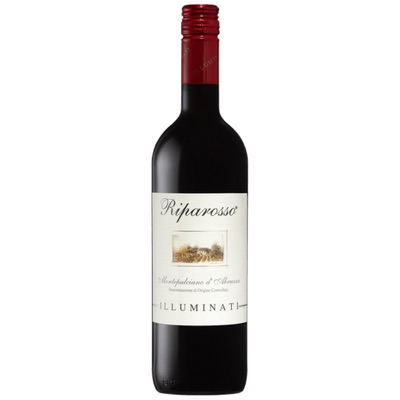
2020 Illuminati
Montepulciano d’Abruzzo Riparosa
($12)—This wine was made from 100% Montepulciano
grapes that were slowly fermented in stainless
steel, temperature-controlled tanks and then aged in
Slavonian oak for 6 months prior to bottling. It has
a bouquet and rich taste of ripe raspberries and
strawberries, with a touch of licorice in its long
finish.
2020 Tenuta
Delle Terre Neuvo Etna Rosso ($21)—Made
from organic grapes (95% Nerello Mascalese and 5%
Nerello Cappuccio) grown in volcanic soil on Mt.
Etna, this wine, with a bouquet and flavors of fresh
strawberry and cherry, has a bit of thyme flavor in
its finish. It’s not as intense as some other Etna
Rossos and mates harmoniously with Thanksgiving
fare.
France
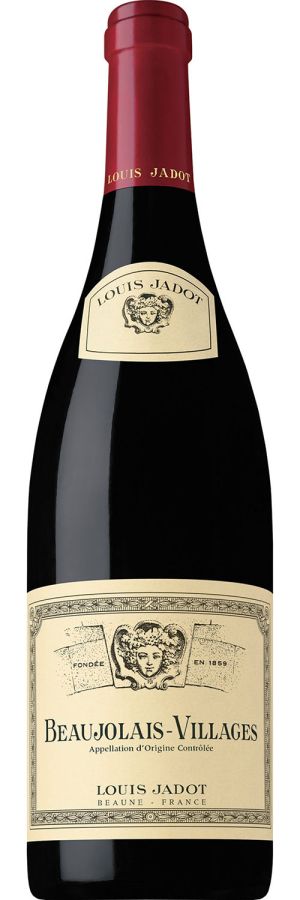
2021 Louis
Jadot Beaujolais-Villages ($13)—This
easy-drinking red made from Gamay grapes grown in
southern Beaujolais is head and heals more enjoyable
than the Nouveaux. It shows a fragrant bouquet and
medium-bodied taste of ripe cherries and
strawberries, with a hint of herbs in its finish
that mates particularly well with turkey.
California
2019 Ridge
Pagani Ranch Zinfandel ($42)—Made
from hand-harvested grapes (90% Zinfandel, 6% Petite
Sirah, 4% Alicante Bouschet), this wine was
fermented using indigenous years and aged in oak
barrels for 14 months. It shows a complex bouquet
and taste of red plums and blueberries, with hints
of orange and some pepper in its smooth, memorable
finish.
Spain
2020 Bodegas
Borsao Garnacha
($9)—This bargain-and-a-half crowd pleaser, hailing
from the Bierzo region in northeastern Spain, is
made from hand-harvested grapes (mainly grenache
with a bit of tempranillo) that are fermented and
aged in stainless steel tanks. It shows a
fruity bouquet and flavors of ripe red plums,
raspberries and cherries, with a hint of licorice
and soft tannins in its smooth finish.
Israel
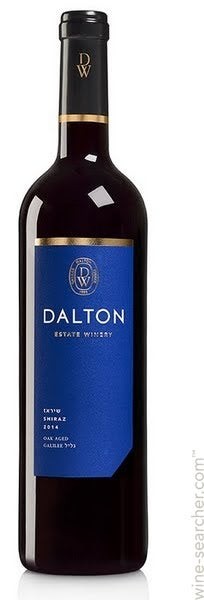
2019 Dalton
Estate Shiraz
($23)—This kosher wine (also perfect for Hanukah)
was made from 100% Shiraz (Syrah) grapes grown in
Israel’s western Galillee region that were fermented
in concrete tanks and then aged for 12 months in
used French oak barrels. It has a bouquet and taste
of ripe plums and cranberry, with a hint of
sweetness in its otherwise crisp finish.
WHITE
France
M. Chapoutier
“La Combe Pilate” Voignier ($20)—While I
find many viognier wines (from France and other
areas) taste under-ripe, or on the other hand too
acidic, this 100% Viognier—from organic grapes grown
biodynamically in the northern Rhone—has a full
bouquet and flavors of ripe peach, lemon zest and
hints of tangerine in its finish crisp.
2019 William
Fevre Domain Chablis
($36)—Usually thought of more as a wine to accompany
seafare, this elegant white has gusto enough to mate
with the full range of Thanksgiving fare, as well as
Cornish hens and duck breasts. Aged only in
stainless steel for 10 months following
fermentation, it shows a bouquet and flavors of ripe
apples, pears and a touch of pineapple, with a
crisp, clean finish.
New Zealand
2022 Kim
Crawford Sauvignon Blanc ($16)—Made in
Marlborough from 100% Sauvignon Blanc grapes, this
very popular, easy-drinking white shows ripe flavors
of tropical fruit, melons and grapefruit and lemon
zest, with its citrusy flavor providing a good
counterbalance to the sweetness of candied
yams cranberry sauce.
Chile
2021 Koyle
Costa La Flor Sauvignon Blanc ($16)—Made
from organic, 100% biodynamically grown Sauvignon
Blanc grapes from rolling hills in Chile’s San
Antonio Valley (about 50 miles from the Pacific
Ocean), this white shows a restrained bouquet and
taste of green apple, grapefruit and lemon zest,
with notes of ginger in its crisp finish.
New York State
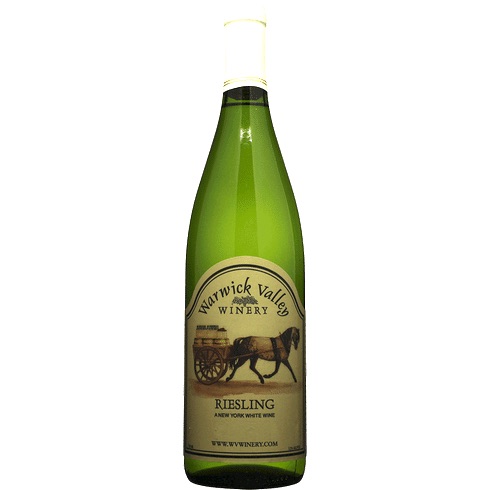
2019 Warwick
Valley Riesling ($14)—Made from
grapes grown in the foothills of the Hudson Valley,
this light, elegant German-style wine has a bouquet
and flavor of ripe peaches and apples with a bit of
sweetness, but a crisp finish. It’s a good choice,
especially with appetizers ranging from bruschetta
to smoked salmon to toasts with olive tapenade, but
also mates well with typical main course items.
California

2019 Sequoia
Grove Carneros Chardonnay ($31)—This
full-bodied white hails from a family-owned winery
in Napa Valley’s Rutherford area, noted for warm
days and cool nights. It shows a lush bouquet and
rich taste of apples, pineapple and toast, with a
long finish containing hints of vanilla and spice.
❖❖❖
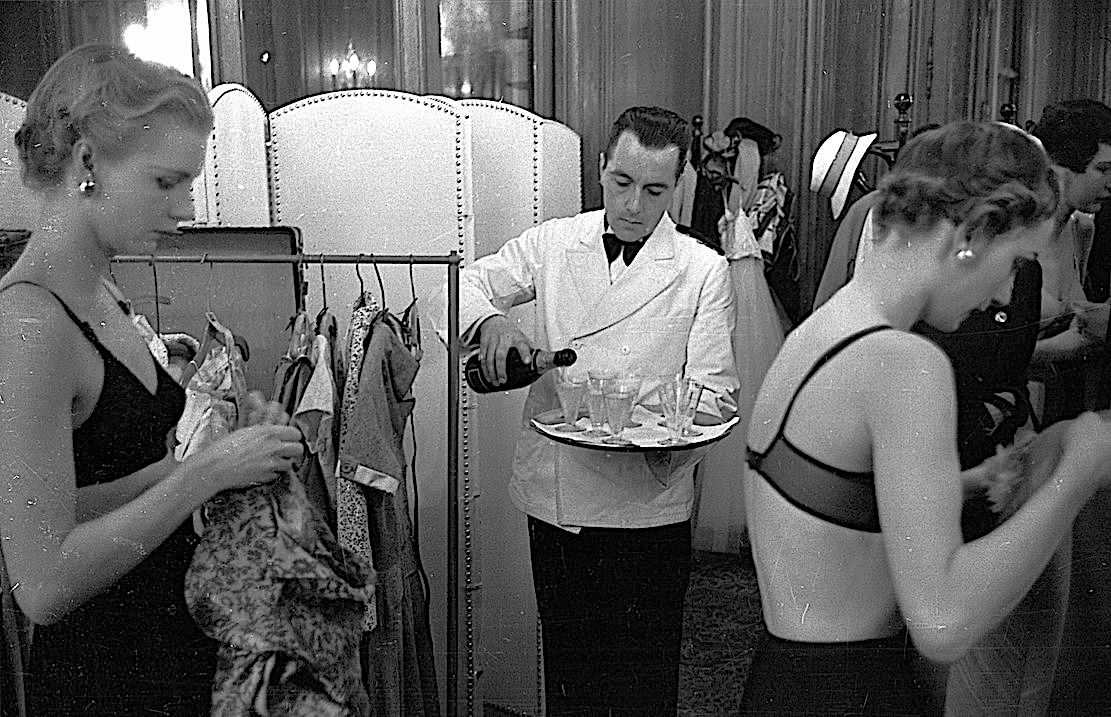 JAH, UND NOW
YOU VILL TELL ME
JAH, UND NOW
YOU VILL TELL ME YOUR FEELINGS ABOUT DER FRANKFURTERS
"Where
the coupe glass is reminiscent of a feminine
body unencumbered, a soft
breast, the V-shaped glass is, by contrast, a
bullet bra. It is sexy like platform spike heels
and a drawn-on beauty mark are sexy, like a whip
is sexy. It is sharp and hard and a little bitchy.
For a long time, the V-glass has been maligned as
being fragile, unwieldy and prone to spillage. But
as the Martini’s—and indeed the broader ’tini
category’s—rein surges on, it’s only natural that
its attendant glass make a triumphant return,
too."—Jaya Saxena, Punch (10/6/22)
❖❖❖
Any of John Mariani's books below may be ordered from amazon.com.
 The Hound in Heaven
(21st Century Lion Books) is a novella, and
for anyone who loves dogs, Christmas, romance,
inspiration, even the supernatural, I hope you'll find
this to be a treasured favorite. The story
concerns how, after a New England teacher, his wife and
their two daughters adopt a stray puppy found in their
barn in northern Maine, their lives seem full of promise.
But when tragedy strikes, their wonderful dog Lazarus and
the spirit of Christmas are the only things that may bring
his master back from the edge of despair.
The Hound in Heaven
(21st Century Lion Books) is a novella, and
for anyone who loves dogs, Christmas, romance,
inspiration, even the supernatural, I hope you'll find
this to be a treasured favorite. The story
concerns how, after a New England teacher, his wife and
their two daughters adopt a stray puppy found in their
barn in northern Maine, their lives seem full of promise.
But when tragedy strikes, their wonderful dog Lazarus and
the spirit of Christmas are the only things that may bring
his master back from the edge of despair. WATCH THE VIDEO!
“What a huge surprise turn this story took! I was completely stunned! I truly enjoyed this book and its message.” – Actress Ali MacGraw
“He had me at Page One. The amount of heart, human insight, soul searching, and deft literary strength that John Mariani pours into this airtight novella is vertigo-inducing. Perhaps ‘wow’ would be the best comment.” – James Dalessandro, author of Bohemian Heart and 1906.
“John Mariani’s Hound in Heaven starts with a well-painted portrayal of an American family, along with the requisite dog. A surprise event flips the action of the novel and captures us for a voyage leading to a hopeful and heart-warming message. A page turning, one sitting read, it’s the perfect antidote for the winter and promotion of holiday celebration.” – Ann Pearlman, author of The Christmas Cookie Club and A Gift for my Sister.
“John Mariani’s concise, achingly beautiful novella pulls a literary rabbit out of a hat – a mash-up of the cosmic and the intimate, the tragic and the heart-warming – a Christmas tale for all ages, and all faiths. Read it to your children, read it to yourself… but read it. Early and often. Highly recommended.” – Jay Bonansinga, New York Times bestselling author of Pinkerton’s War, The Sinking of The Eastland, and The Walking Dead: The Road To Woodbury.
“Amazing things happen when you open your heart to an animal. The Hound in Heaven delivers a powerful story of healing that is forged in the spiritual relationship between a man and his best friend. The book brings a message of hope that can enrich our images of family, love, and loss.” – Dr. Barbara Royal, author of The Royal Treatment.
 |
The Encyclopedia of American Food and Drink by John F. Mariani (Bloomsbury USA, $35) Modesty forbids me to praise my own new book, but let me proudly say that it is an extensive revision of the 4th edition that appeared more than a decade ago, before locavores, molecular cuisine, modernist cuisine, the Food Network and so much more, now included. Word origins have been completely updated, as have per capita consumption and production stats. Most important, for the first time since publication in the 1980s, the book includes more than 100 biographies of Americans who have changed the way we cook, eat and drink -- from Fannie Farmer and Julia Child to Robert Mondavi and Thomas Keller. "This book is amazing! It has entries for everything from `abalone' to `zwieback,' plus more than 500 recipes for classic American dishes and drinks."--Devra First, The Boston Globe. "Much needed in any kitchen library."--Bon Appetit. |
"Eating Italian will never be the same after reading John Mariani's entertaining and savory gastronomical history of the cuisine of Italy and how it won over appetites worldwide. . . . This book is such a tasteful narrative that it will literally make you hungry for Italian food and arouse your appetite for gastronomical history."--Don Oldenburg, USA Today. "Italian
restaurants--some good, some glitzy--far
outnumber their French rivals. Many of
these establishments are zestfully described
in How Italian Food Conquered the World, an
entertaining and fact-filled chronicle by
food-and-wine correspondent John F.
Mariani."--Aram Bakshian Jr., Wall Street
Journal.
"Equal parts
history, sociology, gastronomy, and just
plain fun, How Italian Food Conquered the
World tells the captivating and delicious
story of the (let's face it) everybody's
favorite cuisine with clarity, verve and
more than one surprise."--Colman Andrews,
editorial director of The Daily
Meal.com. "A fantastic and fascinating
read, covering everything from the influence
of Venice's spice trade to the impact of
Italian immigrants in America and the
evolution of alta cucina. This book will
serve as a terrific resource to anyone
interested in the real story of Italian
food."--Mary Ann Esposito, host of PBS-TV's
Ciao
Italia. "John Mariani has written the
definitive history of how Italians won their
way into our hearts, minds, and
stomachs. It's a story of pleasure over
pomp and taste over technique."--Danny Meyer,
owner of NYC restaurants Union Square
Cafe, The Modern, and Maialino.
|
 |
 |
 |
 |
 |
 |
 Everett Potter's Travel Report:
Everett Potter's Travel Report: 
 Eating Las
Vegas
Eating Las
Vegas
MARIANI'S VIRTUAL GOURMET
NEWSLETTER is published weekly. Publisher: John Mariani. Editor: Walter Bagley. Contributing Writers: Christopher
Mariani, Misha Mariani, John A. Curtas, Gerry Dawes, Geoff Kalish.
Contributing
Photographer: Galina Dargery. Technical
Advisor: Gerry
McLoughlin.
If you wish to subscribe to this
newsletter, please click here: http://www.johnmariani.com/subscribe/index.html
© copyright John Mariani 2022
